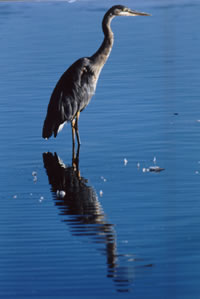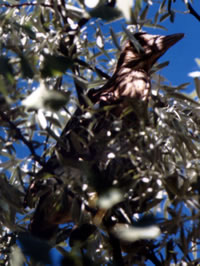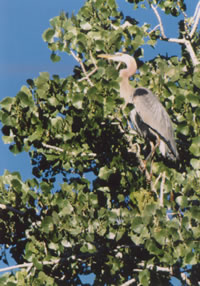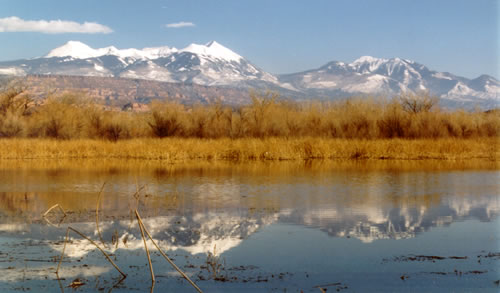| The
fishermen were quietly standing knee-deep in the river. Their
slow movements did little to betray their presence. Occasionally,
one would look up, scan the river’s surface, check on
the sky. Some type of midge formed a smoky mass, their tiny
bodies swirling about in the light April breeze as the fishermen
continued their glacial speed advance upriver.
One stopped mid-stride, tilted its head with sloth-like speed
and stared down into the shallows of the river. A pause and
a momentary calculation, then a lightning quick stab below
the surface. The fishermen raised his long neck out of the
water giving me a quick chance to identify its prey. Though
difficult to tell at this distance, the fish looked to be
a small catfish. My view was quickly interrupted as the fisherman
readjusted its quarry and swallowed the fish bones and all.
Of course, this two-legged fishermen doesn’t carry a
creel or a license or even ran a string for its catch. No,
but what can you expect from a great blue heron?
The four-foot tall great blue heron goes by the nickname Big
Cranky. The nickname is not just because of its height, but
when one gets disturbed, the bird lifts off from its fishing
spot with a loud, low-pitched croak. Displeasure through a
monosyllable grunt.
But the great blue often just flies downstream on its long,
broad wings and finds another fishing hole. In flight the
great blue folds its long neck backwards onto its shoulder,
giving the viewer the impression that the bird lacks a neck.
Unlike cranes, which fly with their necks extended, herons
retract those long necks.
Blue-gray in color, these long-legged creatures nest in colonies
meaning they prefer to nest in close proximity to one another,
often just a tree limb away from their closest neighbor. Herons
may select a large cottonwood tree or even a dense stand of
Gambel’s oak for their nesting neighborhood. In the
crown of the tree the birds build large, relatively flat nests
that may be used year after year.
Great blues are not the only herons to nest here along the
Colorado River. A close relative, the black-crowned night
heron may not be strictly nocturnal, but one often hears a
deep QUOK! as the birds fly overhead at night. Also called
the night raven, due to its raven-like call, this small heron
hunts in the evening hours thus avoiding competition between
itself and great blues. Like their taller cousins, black-crowned
prey on small fish, aquatic insects, frogs, snakes and even
young mice. These birds lack the long, sinuous neck of the
great blue, but their fishing prowess is just as fine - they
are just closer to the water due to their smaller stature.
Whereas great blue heron nests look flimsy, those of the black-crowned
really are. A loose assemblage of sticks constitutes a home,
with perhaps some finer materials woven into the lining. Several
pale blue-green eggs are laid in the nest which the female
constructed, but for which the male collected the building
materials.
Named after their black crown feathers, night herons appear
short and squat in flight. With a short thick neck and broad
wings, the birds seem chunky versus the lanky look of the
great blues. Though these birds frequent areas with extensive
marshes like the Matheson Preserve, they may also be found
in the stream side vegetation along the Colorado River. And
like their stealth moving cousins the great blues, the night
herons’ herald is often heard long before the birds
are seen. |



|





